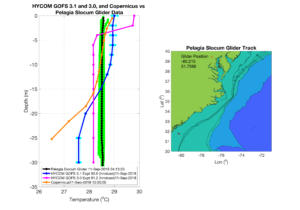-
Pelagia & GOFS and Copernicus Mercator
Posted on September 11th, 2018 No commentsHere is a first look at what the European global ocean model is saying for Pelagia.

SST for Copernicus and GOFS 3.1 (the data assimilative initial condition for RTOFS) both have about the same surface temp.
That would be expected because they are both assimilating the similar global SST products.
Subsurface varies quite a bit between the models. All colder than the models.
GOFS 3.0 is closest to the glider, but likely for the wrong reason, the lower spatial resolution of GOFS 3.0 in shallow water tends to produce isothermal layers in shallow water that then adjust the surface temperature to match the satellite SST.
GOFS 3.1 and Copernicus clearly have the resolution to produce stratified continental shelves.
RTOFS is coming in closer to the glider. It takes a bit of time for the data flow to go through the system from the glider control center to the glider dac to ndbc to gts, so the PELAGIA profiles are probably just starting to appear in the NCEP tanks.
So these model profiles likely have very little data other than SST contributing to the assimilation.
This is what we hope to modify with the glider data and the GOFS 3.1 assimilation scheme.
As before – sending this out as fast as Maria is producing them so we can get this to Debra and Catherine for their briefs.
Thanks Maria. Thanks all.
Scott
Last 5 posts by Scott Glenn
- Early Season in the Mid Atlantic - June 17th, 2021
- Disturbance in the Gulf - June 16th, 2021
- Hurricane Gliders 2021 - May 3rd, 2021
- Hurricane Iota - November 16th, 2020
- Hurricane Eta - Low Wind Shear, High SST - November 2nd, 2020



